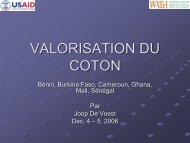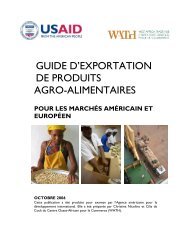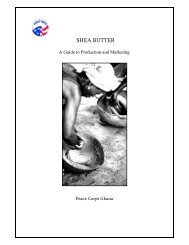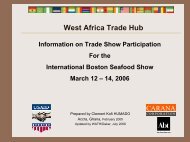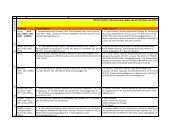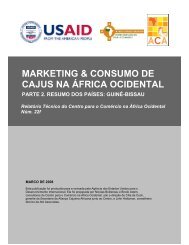A Brief Introduction to Textile Processing - AGOA Export Toolkit
A Brief Introduction to Textile Processing - AGOA Export Toolkit
A Brief Introduction to Textile Processing - AGOA Export Toolkit
You also want an ePaper? Increase the reach of your titles
YUMPU automatically turns print PDFs into web optimized ePapers that Google loves.
Water repellant finishes. These chemical treatments help prevent hydrophilic fabrics such as cot<strong>to</strong>n or<br />
cot<strong>to</strong>n blends repel water that <strong>to</strong>uches the surface of the fabric. Such finishes are widely used for<br />
fabrics intended for raincoats and some other outerwear. Although they do not prevent water from<br />
soaking in<strong>to</strong> the fabric in heavy rains or under prolonged exposure, they do help substantially. Similar<br />
finishes may be applied <strong>to</strong> help prevent soiling when fabric is exposed <strong>to</strong> dirt.<br />
Flame retardant finishes. These finished are mandated by law for certain types of wearing apparel. Most<br />
notable, are the requirements for children’s sleepwear. Anyone considering manufacturing children’s<br />
sleepwear should take care <strong>to</strong> research the current legal requirements for flame retardant finishing.<br />
Garment manufacturing<br />
Garments can be constructed or assembled by either of two methods:<br />
1. cut and sew<br />
2. knit – <strong>to</strong> – shape.<br />
The difference is whether the individual parts, or components, of a garment are cut <strong>to</strong> the necessary<br />
shape from flat fabric, or are produced directly in the shape needed.<br />
Cut and sew<br />
Cut and sew<br />
Garment manufacture<br />
Knit – <strong>to</strong> - shape<br />
Yarn Yarn<br />
Fabric Components<br />
Components Assembly<br />
Assembly<br />
Figure 12. Cut – and – sew vs. Knit – <strong>to</strong> – shape construction<br />
Pattern making. Cut and sew is the more common. Either woven or knit fabrics may be used.<br />
Unlike artisanal methods (including exclusive haute couture and cus<strong>to</strong>m clothing) in which each<br />
individual garment is made one at a time, industrial methods are designed <strong>to</strong> manufacture many<br />
identical units at the same time. In large fac<strong>to</strong>ries thousands of identical units may be made in a single<br />
day. Unlike artisanal methods, under which one worker completes most or all steps of one garment,<br />
industrial methods employ a division of labor whereby one worker may perform only one step in the<br />
preparation and assembly process, pass the component/s on <strong>to</strong> the next worker, who will complete<br />
the next step in assembly. Such methods are employed <strong>to</strong> allow individual workers <strong>to</strong> specialize in<br />
and perfect selected garment assembly steps, and <strong>to</strong> allow greater efficiency in overall manufacturing.<br />
Prepared by Margaret Bishop and Brent Smith for the West Africa Trade Hub 8/04 15



